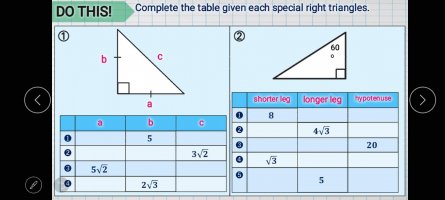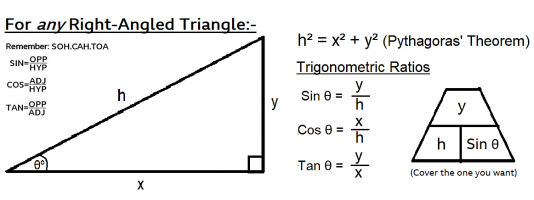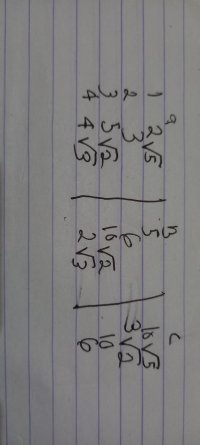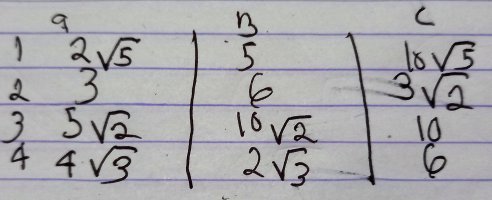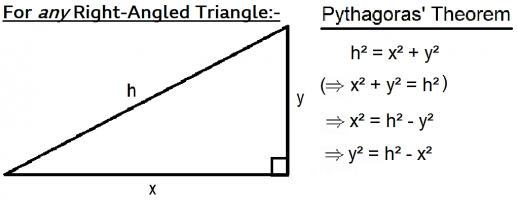You are using an out of date browser. It may not display this or other websites correctly.
You should upgrade or use an alternative browser.
You should upgrade or use an alternative browser.
Hi im having trouble understanding in what to do here i hope someone can help me :)
- Thread starter Sejiro
- Start date
The Highlander
Senior Member
- Joined
- Feb 18, 2022
- Messages
- 1,203
Hi Sejiro,
Welcome to freeMATHhelp. ?
Please read through what I have provided for you below and work your way through the given "revision" in order to be able to tackle the problems you have been given. Then come back as suggested in my Post.
Table 1 is all based on Pythagoras' Theorem. The fact that a & b are of equal length allows you to use that theorem to calculate all the sides' lengths given only one of them,
eg: in Line 1:-
Table 2 is based on your (assumed) knowledge of the EXACT VALUES of certain Trigonometric Ratios (of one angle in particular ?). I am not going to give you an example of how to complete any of these lines until I am sure you have acquired this knowledge and made some attempt at completing at least one of the lines in the table by yourself.
Please come back and show us what you have done/tried and further guidance will be offered at that stage (or confirmation will be given that you have arrived at the correct answers).
In the meantime, to help you get started on table 2, have a look at the worksheet I give out to my students (below).
I get them to copy out the diagrams and fill in the answers in their workbooks because these are what are called the Exact Values for select Trigonometric Ratios that come up all the time in Maths problems (because the values you get on a calculator, with very few exceptions, are all approximations to however many decimal places the device operates).
See if you can complete the worksheet first as the question you have posted is just an extension of that (in Table 2).
(If you are not sure how to complete the Worksheet then have a look at the attached (Reminder) sheet that I also give out to students to keep a note of; studying that should enable you to complete the Worksheet and then your own problem sheet.)
Worksheet:-

Welcome to freeMATHhelp. ?
Please read through what I have provided for you below and work your way through the given "revision" in order to be able to tackle the problems you have been given. Then come back as suggested in my Post.
Table 1 is all based on Pythagoras' Theorem. The fact that a & b are of equal length allows you to use that theorem to calculate all the sides' lengths given only one of them,
eg: in Line 1:-
\(\displaystyle b= 5 \Rightarrow a=5 \Rightarrow 5^2+5^2 = c^2 \Rightarrow c=?\)
Table 2 is based on your (assumed) knowledge of the EXACT VALUES of certain Trigonometric Ratios (of one angle in particular ?). I am not going to give you an example of how to complete any of these lines until I am sure you have acquired this knowledge and made some attempt at completing at least one of the lines in the table by yourself.
Please come back and show us what you have done/tried and further guidance will be offered at that stage (or confirmation will be given that you have arrived at the correct answers).
In the meantime, to help you get started on table 2, have a look at the worksheet I give out to my students (below).
I get them to copy out the diagrams and fill in the answers in their workbooks because these are what are called the Exact Values for select Trigonometric Ratios that come up all the time in Maths problems (because the values you get on a calculator, with very few exceptions, are all approximations to however many decimal places the device operates).
See if you can complete the worksheet first as the question you have posted is just an extension of that (in Table 2).
(If you are not sure how to complete the Worksheet then have a look at the attached (Reminder) sheet that I also give out to students to keep a note of; studying that should enable you to complete the Worksheet and then your own problem sheet.)
Worksheet:-

Attachments
Steven G
Elite Member
- Joined
- Dec 30, 2014
- Messages
- 14,603
I try to multiply the a to b and try to divide the a to c (hypotenuse) or i try to multiply the a to c
If a=b=1, then c = sqrt(2). This is a pythagorean triple. If you multiply each of those 3 numbers by k, then the equality holds.
For example, if I multiply each side by 7, then I get a=b=7*1 and c= 7*sqrt(2).
Based on your answers you do not seem to understand that a=b. On side a and on side b do you see the mark | on each of those two sides. That mark means that those sides are equal in length. So if you are given a, then you know b; if you are given b, then you know a. If you know a and b, then Pythagoras would know exactly what to do.
If a=b=1, then c = sqrt(2). This is a pythagorean triple. If you multiply each of those 3 numbers by k, then the equality holds.
For example, if I multiply each side by 7, then I get a=b=7*1 and c= 7*sqrt(2).
Based on your answers you do not seem to understand that a=b. On side a and on side b do you see the mark | on each of those two sides. That mark means that those sides are equal in length. So if you are given a, then you know b; if you are given b, then you know a. If you know a and b, then Pythagoras would know exactly what to do.
The Highlander
Senior Member
- Joined
- Feb 18, 2022
- Messages
- 1,203
I try to multiply the a to b and try to divide the a to c (hypotenuse) or i try to multiply the a to c
No, No, No! Your answers are NOT "correct"!
Did you even (properly) read the information I gave you about Table 1? ?
That was the easy table to tackle and I even gave you an (almost complete) answer to the first line!
I told you right at the start that the triangle's sides a & b are EQUAL (lengths) in that table so you CANNOT have different answers in the first two columns!
(NB: Please make sure your pictures are the right way round before posting; most of us in here read left to right not top to bottom!).
The first table is based (almost) entirely on Pythagoras' Theorem; are you not familiar with that? You will need to go back and revise it if not*.
You have (by sheer luck, it seems) managed to get a coupler of entries correct (3 & 10) but I suspect that you also need to revise how to Simplify Square Roots, eg:-
\(\displaystyle \sqrt{54}=\sqrt{9×6}=\sqrt{9}×\sqrt{6}=3\sqrt{6}\) (Visit this page for more info.)
I will give you the solution to Line 1 again, this time complete, but you must make an effort to revise and understand all of the topics I have pointed you to before you can have any chance of completing this exercise properly!
\(\displaystyle b=5 \Rightarrow a=5 \Rightarrow \overbrace{5^2+5^2=c^2}^{\text{(by Pythagoras)}} \Rightarrow c^2=25+25 \Rightarrow c^2=50 \\ \Rightarrow c=\sqrt{50} \Rightarrow c=\sqrt{25 × 2} \Rightarrow c=\sqrt{25}× \sqrt{2}\Rightarrow c=5\sqrt{2}\)
So the first line of Table 1 should read: \(\displaystyle 5\rightarrow5\rightarrow5\sqrt{2}\)
Now go back and try again but revise all the topics I have indicated first!
(*I have also added a summary of Pythagoras' Theorem (below) which you can study to see how to manipulate the squared terms.)
Attachments
The Highlander
Senior Member
- Joined
- Feb 18, 2022
- Messages
- 1,203
Hi Steven,I try to multiply the a to b and try to divide the a to c (hypotenuse) or i try to multiply the a to c
If a=b=1, then c = sqrt(2). This is a pythagorean triple. If you multiply each of those 3 numbers by k, then the equality holds.
For example, if I multiply each side by 7, then I get a=b=7*1 and c= 7*sqrt(2).
Based on your answers you do not seem to understand that a=b. On side a and on side b do you see the mark | on each of those two sides. That mark means that those sides are equal in length. So if you are given a, then you know b; if you are given b, then you know a. If you know a and b, then Pythagoras would know exactly what to do.
Thank you for "stepping in". ?
I tried to respond to the OP's (rather feeble) attempt at Table 1 on the problem sheet an hour or so after s/he posted it on Thursday evening (here in UK) but I had no sooner typed up my response (above, qv) than I "lost" my connection to the Forum (again!) and have not been able to get back in since! ?
I'm afraid this OP's 'difficulties' may go far beyond not being able to recognise when two lines are marked as equal lengths; I even pointed this out in my first response (qv)!
It would appear that s/he has been taught about Pythagoras, Square Roots and (Basic R-A Δ) Trigonometry (otherwise, why would s/he have been assigned this particular task?) but has not bothered to retain much, if any, of these topics! Either that or this level of mathematics is simply above his/her ability! ?
I have a suspicion s/he may well be one of those who never come back anyway. ?
I was also going to respond to your reply (to me) in the FOIL thread (I fear you may have misinterpreted my mention of "All roads lead to Rome" ?) but I may never be back in the Forum myself! ?
I have been unable to access the Forum for two whole days now and the only way I managed to get back in just now is by using a VPN (through IP's located in the Netherlands, Japan & the USA!) and what I'm finding is that when I use the VPN I only get one, maybe two, chance(s) to "view" my posts before uploading and then I lose the connection again and have to disconnect the VPN and re-connect, through another foreign IP address, to get the Forum back online! ?
That's far too much trouble for me to waste my time continually trying to re-establish access to the Forum ? so, unless I am suddenly able to access the Forum again without the use of a VPN, then I doubt If I'll be coming back. ?
Shame really, ? because I even went to the trouble of completing the two tables (in a modified picture of the original problem sheet) for the OP (if s/he ever got close to making a decent attempt at working it out for him/herself) but I will leave him/her in your capable hands; Good Luck with that! ?
(My patience was wearing a bit thin anyway. ?)
Cheers, &
Best Regards. ?

